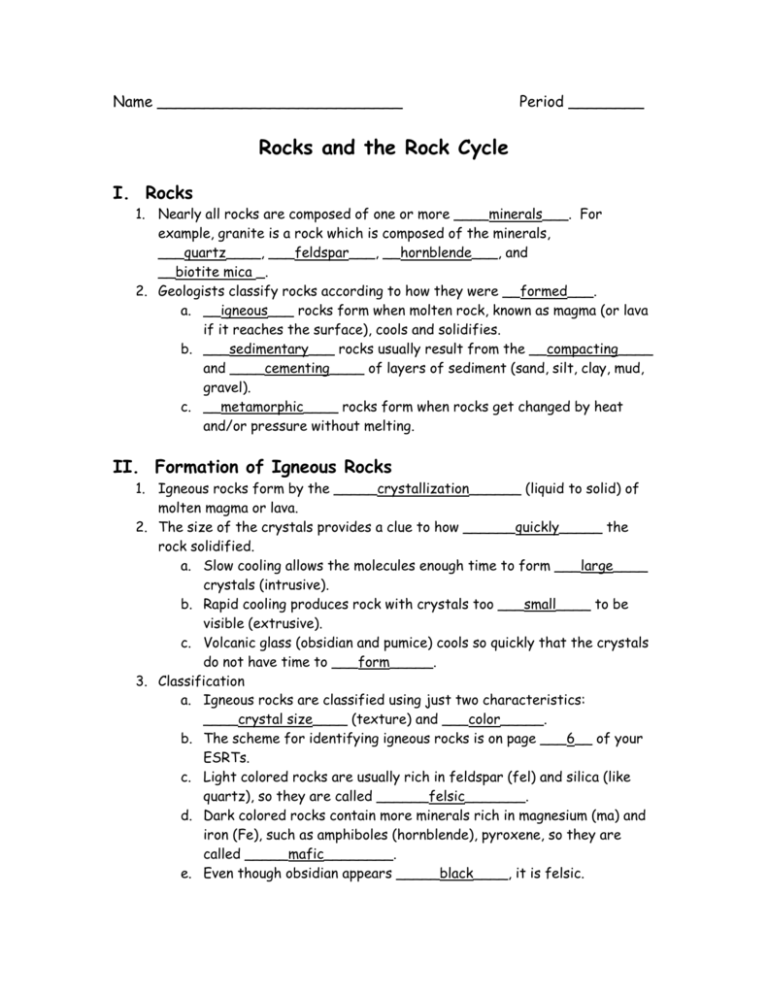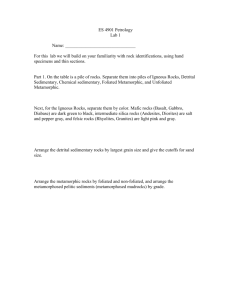Rocks & the Rock Cycle
advertisement

Name __________________________ Period ________ Rocks and the Rock Cycle I. Rocks 1. Nearly all rocks are composed of one or more ____minerals___. For example, granite is a rock which is composed of the minerals, ___quartz____, ___feldspar___, __hornblende___, and __biotite mica _. 2. Geologists classify rocks according to how they were __formed___. a. __igneous___ rocks form when molten rock, known as magma (or lava if it reaches the surface), cools and solidifies. b. ___sedimentary___ rocks usually result from the __compacting____ and ____cementing____ of layers of sediment (sand, silt, clay, mud, gravel). c. __metamorphic____ rocks form when rocks get changed by heat and/or pressure without melting. II. Formation of Igneous Rocks 1. Igneous rocks form by the _____crystallization______ (liquid to solid) of molten magma or lava. 2. The size of the crystals provides a clue to how ______quickly_____ the rock solidified. a. Slow cooling allows the molecules enough time to form ___large____ crystals (intrusive). b. Rapid cooling produces rock with crystals too ___small____ to be visible (extrusive). c. Volcanic glass (obsidian and pumice) cools so quickly that the crystals do not have time to ___form_____. 3. Classification a. Igneous rocks are classified using just two characteristics: ____crystal size____ (texture) and ___color_____. b. The scheme for identifying igneous rocks is on page ___6__ of your ESRTs. c. Light colored rocks are usually rich in feldspar (fel) and silica (like quartz), so they are called ______felsic_______. d. Dark colored rocks contain more minerals rich in magnesium (ma) and iron (Fe), such as amphiboles (hornblende), pyroxene, so they are called _____mafic________. e. Even though obsidian appears _____black____, it is felsic. III. Formation of Sedimentary Rocks 1. Most sedimentary rocks are composed primarily of the ____weathered_____ remains of other rocks. 2. Sedimentary rocks usually form by the ____compacting______ and ____cementing______ of particles of ____sediment____ (sand, mud, silt, clay, gravel, shells). 3. Grains of sediment are usually rounded by abrasion (like sand-blasting) and deposited (settling to the ground) in ______layers_______. a. _____Layering_____ in sedimentary rocks is helpful in distinguishing them from non-sedimentary rocks. 4. Although sedimentary rocks are the most common rocks that you see at the surface, they exist as a relatively ______thin_____ layer over metamorphic and igneous rocks. 5. Characteristics a. The most common sedimentary rocks are the ___clastic______ (fragmental) rocks, which are made up of different ___sized______ particles or fragments. b. The second group of sedimentary rocks is called ___crystalline_____ and form by precipitation (settling) of materials from solution in ____sea water_______. Dolostone, rock _____salt____, and rock ___gypsum______ are some examples. c. The third group of sedimentary rocks is called the ___bioclastic____ sedimentary rocks, which are the result of ancient plant and animal remains. _____coal_____ and some ___limestone______ are examples of bioclastic sedimentary rocks. d. The classification scheme for sedimentary rocks is on page ___7___ of your ESRTs. e. Sedimentary rocks for at or near the ____surface___________. f. Fossils are found almost ____exclusively________ in sedimentary rocks (rarely do igneous or metamorphic rocks have fossils). IV. Formation of Metamorphic Rocks 1. Metamorphic rocks form when sedimentary, igneous, and metamorphic rocks are changed by _____heat________ and/or ____pressure______. a. There is no ____melting_______ involved in the formation of metamorphic rocks, only ___re-crystallization_____ of crystals (minerals). 2. Metamorphic changes include ___crystal____ growth, the formation of new ______minerals______, and an increase in ____density_____, and the distortion of structures (such as the layering). a. Metamorphism often results in the alignment of crystals (minerals), known as ____foliation_______. The following are examples in order of increasing foliation: slate, ___phyllite____, and schist. b. The most intense foliation shows a separation of minerals into light and dark layers, known as _____banding_____. An example is ______gneiss_______. 3. Most metamorphic rocks are formed _______deep______ within the Earth. For example, the metamorphic rocks at the surface of the Adirondack Mountains formed 20 to 30 miles deep within the Earth 1.1 billion years ago. 4. Classification – The classification scheme for metamorphic rocks is on page ____7___ of your ESRTs. V. The Rock Cycle 1. The rock cycle is a model of ______natural______ changes in the rocks and rock material. Rocks cycle through a variety of _______forms_______. 2. The rock cycle is found on page ____6___ of your ESRTs. The rock types are in blocks, the intermediate states (sediments and magma) are in ellipses, and the processes are on the arrows. Follow the arrows from one rock type to another to see how they cycle.







